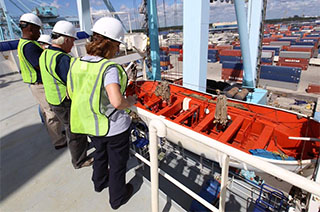Many questions remain unanswered about the sinking of the El Faro in Hurricane Joaquin last month, among them the extent to which the ship's 33 crewmembers were able to initiate self-rescue procedures. A heavily damaged lifeboat and the body of one mariner in a survival suit were found by the Coast Guard during the search and rescue operation. The ship’s voyage data recorder has not been located yet, and the full details of the crew’s ordeal may never be known.
The Coast Guard, meanwhile, wants to learn all it can from the incident in hopes of improving safety on other U.S. commercial vessels.
“We’re discussing a lot of different things in the wake of El Faro, but any real decision-making will probably not happen until after we get the investigation report,” said Brandi Baldwin, chief of the Coast Guard’s Lifesaving and Fire Safety Division. “Until they’ve analyzed all the data, it’s really hard to make any conclusions, but we do look at all of our rules after every situation involving casualties, and this will be no different.”
Any recommendations for improvements to Coast Guard regulations or processes that emerge from the investigation of the El Faro sinking are more likely to affect commercial bluewater ships rather than those that ply the inland and coastal waterways, Baldwin said.
“The domestic fleet is just not subjected to the same kinds of pressures that ships on transoceanic routes face,” she said. “We are signatories to the [International Convention for the] Safety of Life at Sea (SOLAS) treaty and we do adopt those standards into our regulations for our international fleet, and we incorporate many of those rules we think are necessary to ensure the safety of the domestic fleet.”
Of all the safety equipment carried by commercial vessels, perhaps nothing has come under more scrutiny since the sinking of the Titanic than lifeboats. The condition and accessibility of lifeboats aboard the El Faro has been called into question in the weeks since the ship sank. The first version of SOLAS was adopted in 1914 in response to the Titanic disaster, and its subsequent revisions have resulted in many improvements in the design and use of lifeboats, but experts say problems persist.
Over time, lifeboats have become much safer and more seaworthy, as technological advancements such as on/off load release functions and the drop-in ball system pioneered by Viking Nadiro and other lifeboat manufacturers have been implemented. But the wide variety of vessels aand ships and the patchwork of regulations governing lifeboats have caused difficulties for designers, said Henrik Helsinghof, director of Viking Nadiro’s lifeboat/hook retrofit division.
A 2006 report issued by Gard, a maritime insurance provider, pointed out serious problems in on-load release hooks used for most lifeboats. Such release problems resulted in several deaths and serious injuries, mostly during training exercises, but they were also partially blamed for the loss of 123 mariners on the Alexander Kielland rig, which capsized in 1980 in Norway.
A recent update to International Maritime Organization rules requiring the standardization of release hook design is a good start, Helsinghof said, but he would like to see the IMO tackle the issue of maintenance, which he said has largely been overlooked.
“It’s important to have a clearer guidance of the service of the lifeboats. Regular servicing of lifeboats systems are not mandatory under IMO regulations, it’s just a guidance,” he said. “Because lifeboats and their systems are not regularly maintained, crews are not always sure how they work and don’t learn how to use the equipment and parts degrade and can not function properly in case of an emergency.”
Not all maritime losses are preventable, but the Coast Guard's Baldwin and Helsinghof agreed that tragedies such as the Alexander Kielland and El Faro are stark reminders to regulators, shipowners and crews that safety should be the top priority when planning a voyage.





